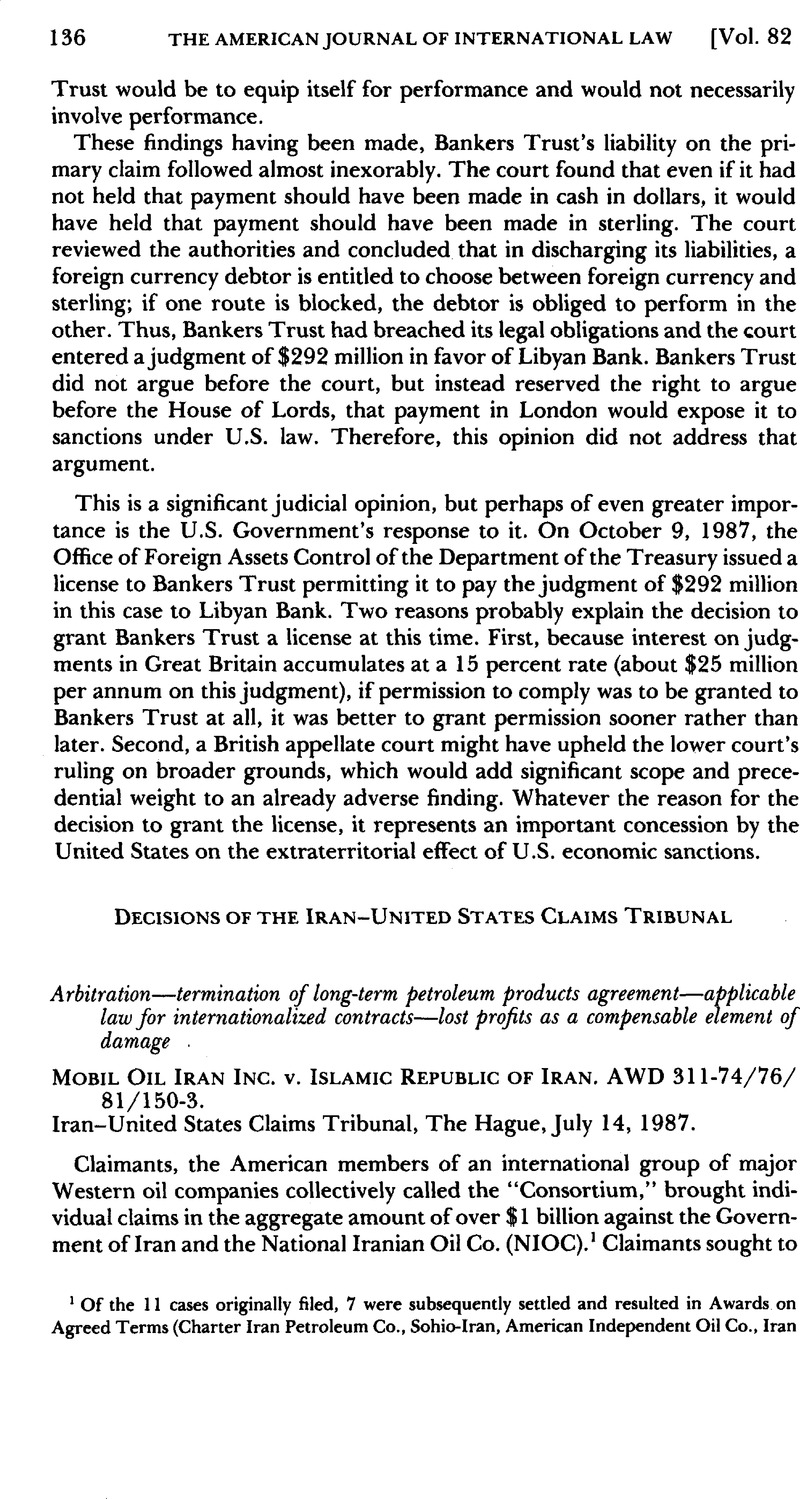Article contents
Mobil Oil Iran Inc. v. Islamic Republic of Iran
Published online by Cambridge University Press: 27 February 2017
Abstract

- Type
- Judicial Decisions
- Information
- Copyright
- Copyright © American Society of International Law 1988
References
1 Of the 11 cases originally filed, 7 were subsequently settled and resulted in Awards on Agreed Terms (Charter Iran Petroleum Co., Sohio-Iran, American Independent Oil Co., Iran Chevron Oil Co., Transocean Gulf Oil Co., Getty Iran Inc., and Texaco Iran Ltd.). The four remaining claimants were Mobil Oil Iran Inc., San Jacinto Eastern Corp., Arco Iran, Inc. and Exxon Corp. The Chamber consolidated the hearings of the claims of the oil companies because they all arose out of the same contract.
2 For background information on the Iran-United States Claims Tribunal, see 77 AJIL 642 (1983). These cases, like many others, were “bifurcated” for the purpose of consideration by the Chamber. In Phase 1 the Chamber undertook to consider three issues: jurisdiction, liability and elements of damages. In Phase 2 the Tribunal will consider quantification of damages and counterclaims by Iran.
3 AWD 311–74/76/81/150–3, slip op., para. 175. The Chamber found that claimants were entitled to compensation for capital advances by them that were to be treated as prepayments for future oil deliveries; assets transferred to NIOC in 1973 in liquidation of a 1954 agreement (known as the 1954 “Consortium Agreement”); and the taking of certain crude oil and natural gas liquid products that claimants were prevented from lifting. The Chamber rejected claimants’ claim for losses on refining operations at Abadan based on alleged breaches of the 1973 agreement’s cost provisions, but it invited claimants to resubmit the claim under a different legal theory.
4 See Amoco Iran Oil Co. v. Iran, ITL 12–55–2 (Dec. 30, 1982), 1 Iran-U.S. Claims Tribunal Rep. [hereinafter Iran-U.S. C.T.R.] 493 (1981–82); Philips Petroleum Co., Iran v. Iran, ITL 11–39–2 (Dec. 30, 1982), id. at 487.
5 See Libyan American Oil Co. v. Government of the Libyan Arab Republic (Apr. 12, 1977) (Mahmassani, Arb.), 20 ILM 1 (1981); Kuwait and American Independent Oil Co. (Mar. 24, 1982) (Reuter, Sultan & Fitzmaurice, Arbs.), 21 ILM 976 (1982); Texas Overseas Petroleum Co./California Asiatic Oil Co. v. Government of the Libyan Arab Republic (Jan. 19, 1977) (Dupuy, Arb.), 17 ILM 3 (1978).
6 Slip op., para. 81.
7 Id., para. 78. Article 29 of the 1973 agreement provided that the “Agreement shall be interpreted in accordance with the laws of Iran.” Id., para. 59.
8 Id., para. 111.
9 This decision is consistent with other Tribunal awards on the effect of the force majeure conditions prevailing in Iran. See, e.g., Sylvania Technical Systems, Inc. v. Iran, AWD 180–64–1 (June 27, 1985) (Chamber 1); Starrett Housing Corp. v. Iran, ITL 32–24–1 (Dec. 19, 1983), 4 IRAN-U.S. C.T.R. 122 (1983 III).
10 Slip op., para. 119.
11 Id., para. 122. As a consequence of this finding, the Chamber found that no expropriation had occurred. Id., para. 130.
12 Id., para. 126.
13 Id., para. 161.
14 Id.
15 Id., para. 175.
16 Brower likened such a characterization to supposing “that a condemned man who spurns the ritual proffer of a blindfold when marched before the firing squad thereby consents to his execution.” Concurring Opinion of Arbitrator Brower, para. 2.
- 1
- Cited by




